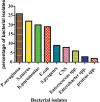Isolation and in vitro evaluation of bacteriophages against MDR-bacterial isolates from septic wound infections
- PMID: 28719657
- PMCID: PMC5515400
- DOI: 10.1371/journal.pone.0179245
Isolation and in vitro evaluation of bacteriophages against MDR-bacterial isolates from septic wound infections
Abstract
Multi-drug resistance has become a major problem for the treatment of pathogenic bacterial infections. The use of bacteriophages is an attractive approach to overcome the problem of drug resistance in several pathogens that cause fatal diseases. Our study aimed to isolate multi drug resistant bacteria from patients with septic wounds and then isolate and apply bacteriophages in vitro as alternative therapeutic agents. Pus samples were aseptically collected from Rajiv Gandhi Institute of Medical Science (RIMS), Kadapa, A.P., and samples were analyzed by gram staining, evaluating morphological characteristics, and biochemical methods. MDR-bacterial strains were collected using the Kirby-Bauer disk diffusion method against a variety of antibiotics. Bacteriophages were collected and tested in vitro for lytic activity against MDR-bacterial isolates. Analysis of the pus swab samples revealed that the most of the isolates detected had Pseudomonas aeruginosa as the predominant bacterium, followed by Staphylococcus aureus, Klebsiella pneumoniae and Escherichia coli. Our results suggested that gram-negative bacteria were more predominant than gram-positive bacteria in septic wounds; most of these isolates were resistant to ampicillin, amoxicillin, penicillin, vancomycin and tetracycline. All the gram-positive isolates (100%) were multi-drug resistant, whereas 86% of the gram-negative isolates had a drug resistant nature. Further bacteriophages isolated from sewage demonstrated perfect lytic activity against the multi-drug resistant bacteria causing septic wounds. In vitro analysis of the isolated bacteriophages demonstrated perfect lysis against the corresponding MDR-bacteria, and these isolated phages may be promising as a first choice for prophylaxis against wound sepsis, Moreover, phage therapy does not enhance multi-drug resistance in bacteria and could work simultaneously on a wide variety of MDR-bacteria when used in a bacteriophage cocktail. Hence, our results suggest that these bacteriophages could be potential therapeutic options for treating septic wounds caused by P. aeruginosa, S. aureus, K. pneumoniae and E. coli.
Conflict of interest statement
Figures





References
-
- Church D, Elsayed S, Reid O, Winston B, Lindsay R (2006) Burn wound infections. Clinical microbiology reviews 19: 403–434. doi: 10.1128/CMR.19.2.403-434.2006 - DOI - PMC - PubMed
-
- Bisno AL, Stevens DL (1996) Streptococcal infections of skin and soft tissues. New England Journal of Medicine 334: 240–246. doi: 10.1056/NEJM199601253340407 - DOI - PubMed
-
- Janda J, Abbott S, Brenden R (1997) Overview of the etiology of wound infections with particular emphasis on community-acquired illnesses. European journal of clinical microbiology & infectious diseases 16: 189–201. - PubMed
MeSH terms
LinkOut - more resources
Full Text Sources
Other Literature Sources
Medical

